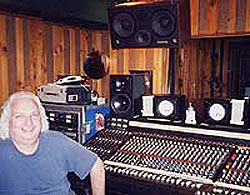
BB: Why the drum riser?
SY: Drum risers change the sound of drums a lot. It’s very hard to find a good sounding drum riser but when you get one, the perspective of drums in the mix is totally different.
It changes the way the drums sit in the mix. When they are not connected to the floor, it becomes a whole different animal. It’s the same if you have a guitar amp on the floor.
It couples with the floor, and the floor becomes and extension of the speaker, so you get all this low stuff that you have to roll off or filter out. The same thing happens with drums. They become part of the floor.
You get more clarity with the riser, usually with even more bottom. In the final mix, the drums are in a place that is a better place than being on the floor. I’ve tried building risers at various times, using the heaviest lumber, but sometimes it just doesn’t work well. They are hard to do.
BB: Let’s move along to another album that endures as a classic, Van Morrison’s Moondance.
SY: We recorded a lot of Moondance on eight track, I’m pretty sure. I don’t remember the studio being sixteen at the time. The band played great. It went very fast. Van didn’t talk much at all.
He’s a very introverted guy. The only thing I remember him saying during all those sessions, was, “Can you put more bottom on my voice, “ because he has a very thin sounding voice.
BB: And those sessions were all done at A&R?
SY: Yes, but in two different rooms.
BB: How did you get assigned to those sessions?
SY: It was all up to the girls who did the book at the studio, who assigned the engineers for the sessions. Producers would call and book the studio, and they would ask who’s available. Those girls could make or break your career.
BB: On Moondance, what else different, compared to Big Pink.
SY: Van recorded the vocals live, in a booth, and I had a Pultec on him. It was simply a matter of capturing the sound of him and his band, but in my way.
You see, if you listen to the records I’ve done, you’ll hear that they all sound different, because I’m recording different bands or the same band at different times in their career. Each one has their own personality and sound.
But I suppose you can hear me, maybe you can hear my drum sound, and my overall thing—whatever it is I do, just trying to capture the band but in the process developing my own sound.
But all of those bands were totally different, not like today where a lot of what you hear all sound like they were done by the same producer on the same board in the same studio. There’s a sameness to the sound.
I was on a committee to pick the nominees for the best engineered record for the Grammy awards, and we had over 170 CDs to listen to, and out of the I only found five that really sounded different.
But that didn’t happen back then. I have to be careful about talking about, “back in the day,” because people say, “Well, that’s old.”
Well, just because it’s old doesn’t it’s wrong, and just because it was the original way or recording doesn’t mean it doesn’t have value today.
